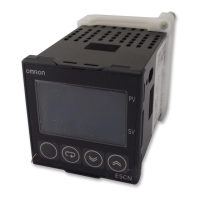54
Determining PID Constants (AT, ST, Manual Setup) Section 3-8
This procedure sets the ST stable range to 20.0°C.
3-8-3 RT (Robust Tuning)
• When AT or ST is executed with RT selected, PID constants are automat-
ically set that make it hard for control performance to degenerate even
when the characteristics of the controlled object are changed.
• RT can be set in the advanced function setting level when PID control has
been set.
• The RT mode cannot be selected while an analog input is set.
• Selecting the RT mode in the following cases will help to prevent hunting
from occurring.
• When the set temperature is not constant and is changed in a wide
range
• When there are large variations in ambient temperatures due to factors
such as seasonal changes or differences between day and night tem-
peratures
• When there are large variations in ambient wind conditions and air flow
• When heater characteristics change depending on the temperature
• When an actuator with disproportional I/O, such as a phase-control-
type power regulator, is used
• When a rapidly heating heater is used
• When the control object or sensor has much loss time
• When hunting occurs in normal mode for any reason
• PID constants are initialized to the factory settings by switching to RT
mode.
• When the RT mode is selected, the derivative time setting unit be-
comes the second.
RT Features • Even when hunting occurs for PID constants when AT or ST is executed
in normal mode, it is less likely to occur when AT or ST is executed in RT
mode.
Advanced Function Setting Level
1. Select the ST Stable Range parameter by pressing the M Key in the ad-
vanced function setting level.
2. Use the U Key to set the parameter to 20.0
°C.
C
st-b
1%0
ST Stable
Range
C
st-b
2*0
rt
Temperature Temperature
Much hunting occurs.
Set value Set value
Start of control Start of control
Time Time
Hunting is reduced.

